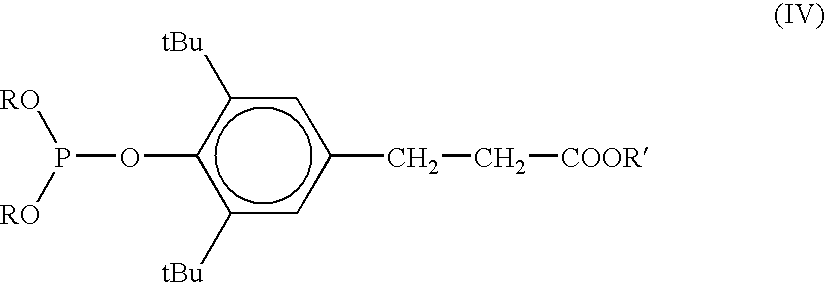Polytrimethylene terephthalate having a low level of acrolein and a process for producing the same
a technology of polytrimethylene terephthalate and acrolein, which is applied in the chemical characteristics of monocomponent polyesters, textiles and paper, fibres, etc., can solve the problems of poor retention of phosphite in the final polymer, the disadvantage of solid state polymerization, and the friability of ptt pellets
- Summary
- Abstract
- Description
- Claims
- Application Information
AI Technical Summary
Benefits of technology
Problems solved by technology
Method used
Image
Examples
example 1
[0040] General Procedure. A 5 liter conical reactor equipped with a helical stirrer, hot oil heating, distillation column, and vacuum capability was charged with 1934 g terephthalic acid, 0.6 gm Irganox 1076 stabilizer, 8.5 g of a PDO solution containing cobalt acetate and antifoam agent (15 ppm Co and 0.5 ppm antifoam based on polymer), 2 g of a PDO / acetic acid solution of titanium butoxide catalyst (15 ppm Ti based on terephthalic acid) and 1131 g PDO. The esterification stage was conducted by pressurizing to about 30 psig (1035 kPa), stirring at about 150 rpm and heating to 255 ˜260° C. for a total of about 120-140 minutes while distilling off water and some PDO. The reactor was returned to atmospheric pressure and an additional 8.8 gm of the titanium butoxide catalyst solution (65 ppm Ti based on terephthalic acid) was added. The prepolymerization stage was conducted at about 260° C. and the pressure was gradually reduced to 40 torr (5.3 kPa; 53 mbar) over 30 minutes and held fo...
example 2
[0055] Generally, the addition point of the phosphorous compound did not make much difference. Table 5 summarizes the results for compounds added with the initial charge or added at the end of the esterification. CEPA was retained very well in both cases. Retention of TEPA in the polymer was slightly better when added at the end of esterification. Trimethylphosphite was retained slightly better when added at the beginning.
[0056] Two additional phosphites, Irgafos and Ultranox, which were added at the beginning because they are not soluble in PDO, are included in this Table. Like trimethylphosphite, addition at the beginning did not result in high retention efficiency, even though both of these compounds have significantly higher molecular weights.
TABLE 5TiPCatAddnFinalIV***AcroleinfinalP / TiExperimentType(ppm)Point**Amps(dl / g)(ppm)***(ppm)% Pmolb*L*Exp. 4 CEPA (+)phosphonate15 + 65end54.40.642735970.723.574Exp. 2 CEPA (+)acid15 + 65charge59.50.652434940.793.674Exp. 34 TriMe Phosph...
example 3
[0057] The phosphorous compounds tend to reduce yellow color (b*) and increase “whiteness” (L*), as mentioned in the discussion above (see Tables 3, 4, and 5). Compared to the controls, with average b*=10 and L*=72, the preferred compounds (e.g. CEPA) usually improved b* to between −1 and 9 and / or improved L* to between 72 and 78, depending on the compound, the concentration, and P / Ti ratio.
PUM
| Property | Measurement | Unit |
|---|---|---|
| Fraction | aaaaa | aaaaa |
| Fraction | aaaaa | aaaaa |
| Fraction | aaaaa | aaaaa |
Abstract
Description
Claims
Application Information
 Login to View More
Login to View More - R&D
- Intellectual Property
- Life Sciences
- Materials
- Tech Scout
- Unparalleled Data Quality
- Higher Quality Content
- 60% Fewer Hallucinations
Browse by: Latest US Patents, China's latest patents, Technical Efficacy Thesaurus, Application Domain, Technology Topic, Popular Technical Reports.
© 2025 PatSnap. All rights reserved.Legal|Privacy policy|Modern Slavery Act Transparency Statement|Sitemap|About US| Contact US: help@patsnap.com



